A Novel Technique of Fabricating a Modified Removable Provisional Prosthesis over an Autologous Bone Grafted Maxillary Anterior Edentulous Segment Prior to Implant Placement
Leoney Andonissamy1, N. Sri Vidhya2
1 Associate Professor, Department of Prosthodontics, Rajah Muthiah Dental College, Annamalai University, Chidambaram, Tamil Nadu, India.
2 Tutor, Department of Prosthodontics, Rajah Muthiah Dental College, Annamalai University, Chidambaram, Tamil Nadu, India.
NAME, ADDRESS, E-MAIL ID OF THE CORRESPONDING AUTHOR: Dr. Leoney Andonissamy, No.17 Pt, Second Main Road, Cauvery Nagar, Reddiarpalayam, Puducherry-605010, India.
E-mail: antony.leoney@gmail.com
Implant dentistry has provided a lot of surgical as well as prosthetic techniques for improving the success of the implants. The surgical technique commonly followed now prior to implant placement is bone grafting procedure. One of the commonest techniques is the use of autologous block graft harvested from mandibular chin region. However, interference in healing as well as excessive bone resorption due to the use of removable provisional prosthesis over the bone grafted region has been commonly observed/reported. Hence now-a-days, fixed provisional prosthesis is preferred over removable provisional prosthesis for the added advantages of superior aesthetics and patient acceptance. This article highlights a new technique of fabricating removable provisional prosthesis, which is superior in aesthetics and strength, consumes less chair time and exerts zero pressure onto the grafted site.
Bone graft,Bone resorbtion,Fixed provisional prosthesis
Introduction
Implant dentistry has undergone many leaps and bounds in the last 10 years. Provisional restorations for implants have also undergone major changes. The various provisional restorations available are Removable Provisional Prosthesis (RPP), Essix appliance and Fixed Provisional Prosthesis (FPP) which includes fixed tooth supported provisionals, transitional provisional implants and implant retained provisionals which may be either cement or screw retained [1,2]. FPP have almost replaced RPP mainly due to patient acceptance, comfort, superior aesthetics and non interference in healing of bone grafted/implant site [3-5]. But FPPs also have their own limitations of poor strength, decreased durability and constant need of repair [6,7]. This article highlights a novel technique in fabrication of a removable provisional prosthesis which would not exert pressure on the grafted site thereby facilitating an uneventful healing phase.
CLINICAL HISTORY
Male patient aged 23 was referred from the Department of Periodontics to the Department of Prosthodontics, for replacement of missing maxillary right central incisor tooth [Table/Fig-1,2].
Intraoral labial view showing.
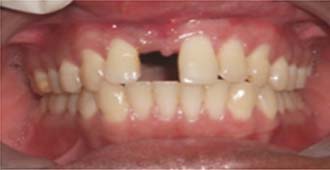
Intraoral occlusal view. (Images from left to right)
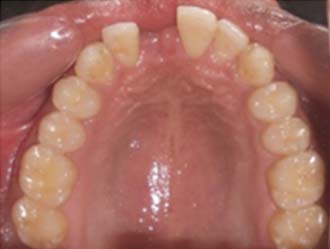
Patient’s history revealed that the patient was suggested replacement of the missing tooth by means of dental implant after augmentation of the horizontally deficient edentulous segment with bone graft. Subsequently, autologous block bone graft was harvested from patient’s anterior mandibular region immediately inferior to mandibular incisor teeth and secured in relation to the missing maxillary right central incisor region by means of stainless steel screw three weeks prior as evidenced from occlusal radiograph [Table/Fig-3].
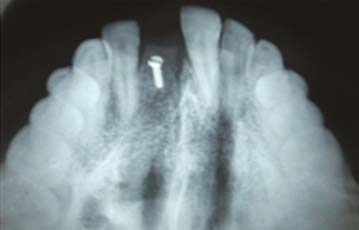
Patient was advised to wait for a period of three to four months for proper healing of the grafted site after which implant was proposed to be placed. Patient needed a provisional prosthesis to replace the missing teeth till definitive implant prosthesis could be given. Patient was suggested two treatment options, namely RPP and FPP. Patient gave his consent for RPP against FPP due to reasons of easy retrievability, reuse, least invasiveness to adjacent teeth and lower economic cost. Hence, written informed consent was obtained following the objectives of the Declaration of Helsinki (2013).
Now for the graft tissue from getting excessively resorbed, it was imperative to give an RPP which was least pressure exerting on the graft site. Hence, a modified type of RPP was planned and the new design was presented before the ethical committee for approval of the new design. After obtaining the ethical committee’s approval, the fabrication of the new type of RPP was initiated.
TECHNIQUE
Maxillary and mandibular impressions were made with Alginate (Algitex) impressions (Dental products of India, Mumbai, India).
Impressions were poured with Type III dental stone (Goldstone, Asian chemicals, Rajkot, India).
Modeling wax (Bensonssurgico, New Delhi, India) of 2 mm thickness was adapted over the edentulous anterior segment to provide relief in the RPP ([Table/Fig-4], arrow ‘A’).
Wax relief given as indicated by arrow ’A’, followed adaptation of stainless steel wire on the cast.
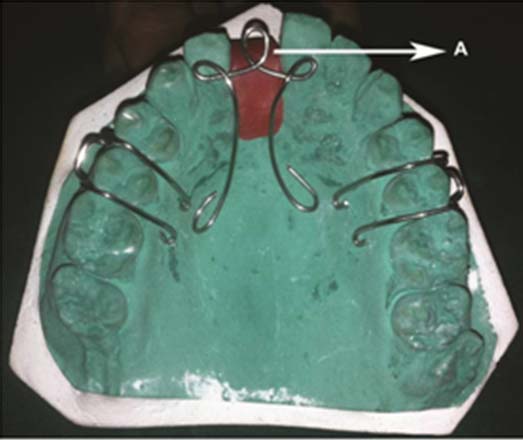
Adaptation of stainless steel wire onto the cast. A 19 gauge orthodontic stainless steel wire (Aura enterprises, Haryana, India) was taken and wire bending was done in such a manner so that three loops were created, one central loop to support the pontic and two lateral loops to act as cingulum stops to prevent the RPP from contacting the grafted edentulous site. Retentive clasps were also fabricated in relation to right and left maxillary second premolar [Table/Fig-4].
Addition silicone putty matrix (Speedex putty, coltene/whale dentInc., Alstatten, Switzerland) was fabricated to accurately capture relief [Table/Fig-5].
Permanent relief given addition silicone putty index used to capture relief.
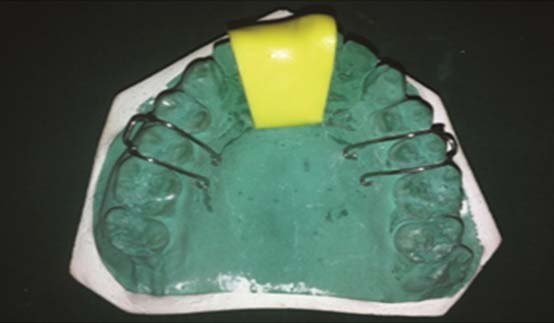
Permanent relief was done by means of Type II dental stone (Gyprock, Asian chemicals).
Wax up was done.
RPP was fabricated by means of clear acrylic heat cured acrylic resin [Table/Fig-6].
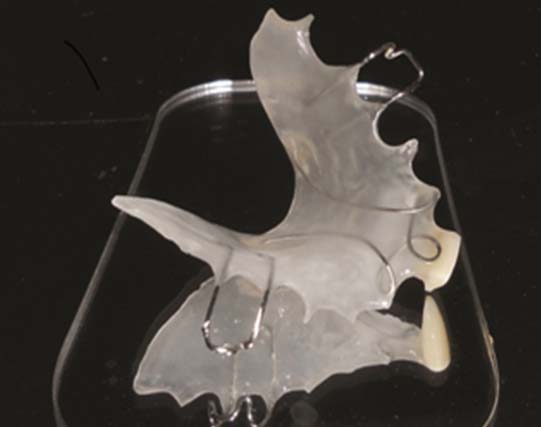
Denture insertion was done [Table/Fig-7,8] and
Post isertion labial view.
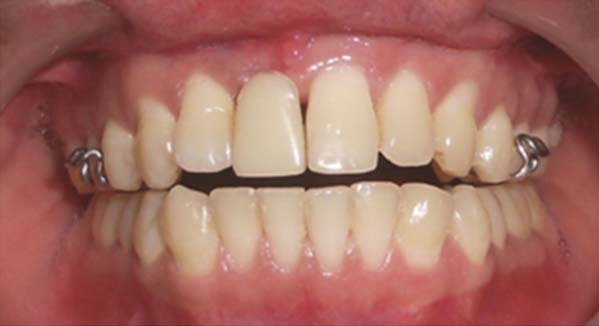
Post insertion occlusal view.
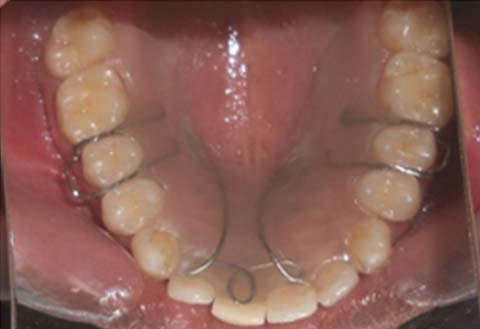
Post insertion adjustments were carried out.
Discussion
RPP has been known to exert undue pressure on the grafted/implant site [1,2], but the technique followed in this article has completely eliminated the pressure factor. Hence, pressure induced resorption was curbed. Aesthetics of the provisional has been kept to optimum limit due to the usage of shell teeth. Similar aesthetic results have been obtained by the use of ovate pontics [4,7]. The prosthesis could be used till the delivery of definitive prosthesis, which could be more economical and less chairside consuming than the fixed provisional prosthesis [3,5]. Postinsertion adjustments were practically nil in the grafted site indicating total relief of the healing tissue.
Repair and relining of the provisional is not required by this type of provisional prosthesis as against fixed provisionals which constantly have to be redone or repaired every time a surgical/prosthetic procedure is undertaken in the grafted/implant site [6]. The technique provides a tooth as well as tissue supported provisional prosthesis against a completely tooth/implant supported fixed provisional or a completely tissue supported RPP.
Conclusion
The technique is economical, less time consuming and the provisional obtained has good aesthetics without compromising on strength and durability of the provisional. This type of provisional is best indicated when the patient needs multiple procedures before the delivery of definitive prosthesis. To conclude, this provisional prosthesis is tooth and tissue supported which could be an alternative for RPP or FPP.
[1]. Cho SC, Shetty S, Froum S, Elian N, Tarnow D, Fixed and removable provisional options for patients undergoing implant treatment Compend Contin Educ Dent 2007 28(11):604-08. [Google Scholar]
[2]. Santosa RE, Provisional restoration options in implant dentistry Aust Dent J 2007 52(3):234-42. [Google Scholar]
[3]. Cibirka RM, Linebaugh ML, The fixed/detachable implant provisional prosthesis J Prosthodont 1997 6:149-52. [Google Scholar]
[4]. Kan JYK, Rungcharassaeng K, Kois JC, Removable ovate pontic for peri-implant architecture preservation during immediate implant placement Pract Proced Aesthet Dent 2001 13:711-15. [Google Scholar]
[5]. Wohrle PS, Single-tooth replacement in the aesthetic zone with immediate provisionalization: fourteen consecutive case reports Pract Periodontics Aesthet Dent 1998 10:1107-14. [Google Scholar]
[6]. Patras M, Naka O, Doukoudakis S, Pissiotis A, Management of provisional restorations’ deficiencies: a literature review J Aesthet Restor Dent 2012 24(1):26-38. [Google Scholar]
[7]. Priest G, Aesthetic potential of single-implant provisional restorations: selection criteria of available alternatives J Aesthet Restor Dent 2006 18:326-38. [Google Scholar]